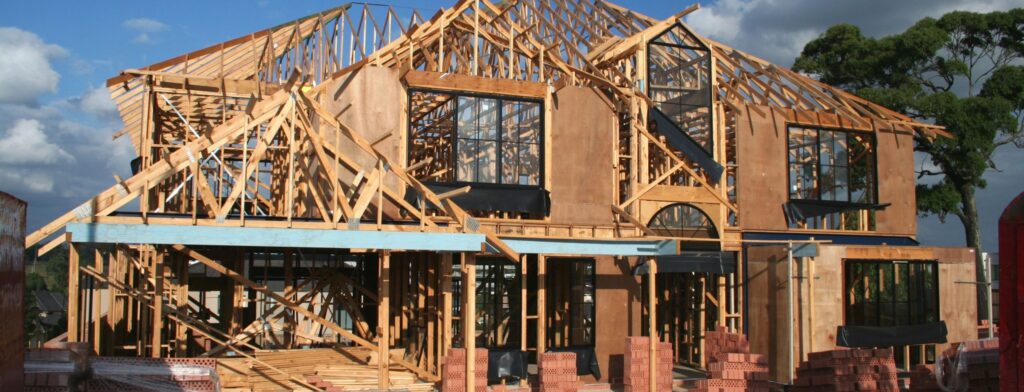More people are opting for self-build mortgages as self-build projects gain traction. This special type of mortgage isn’t like traditional property finance, though. Anyone thinking of getting a self-build mortgage needs to understand how this financing works and how to get the best loan. Here’s everything you need to know.
Understanding self-build mortgages
Before looking at self-build mortgages, it can be helpful to understand why people look at taking on this type of project in the first place.
There are several advantages for self-builds. Because you’re undertaking a lot of the building work yourself (whether its physically doing the work or overseeing other people do it), there’s a lot of room for building or renovating a property for significantly less money than you’d need to spend if you buy a finished home that’s already on the market.
Self-builds can mean that you can use some of your creativity to build the property of your dreams. You might also want a more personalised home. This isn’t simply choosing which taps look great with your kitchen sink – it can be about much more. For example:
- What materials you use and where you source them
- Which tradespeople and suppliers you use
- How eco-friendly your house is
- What your house looks like and the interior layout
It’s important not to mix self-builds with custom builds. A self-build is when you own the piece of land you will build (or renovate) on, and you are completely in charge of the overall project, and everything needed to make the project happen. Self-build doesn’t necessarily mean you carry out the building work yourself – you might work with a builder or building team for some or all of the project.
Custom builds are different because you are a little more hands-off and generally aren’t involved in day-to-day project management, sourcing builders and experts, etc. You’ll have a lot of control over the build and customisation of your home, but you’ll usually be working with a developer who will take over the more complex or technical parts of the project as well as the overall management.
How do self build mortgages work?
In a traditional mortgage, your lender releases the complete sum of money at once. This allows you to effectively buy the house from someone else by giving them a lump sum that covers the cost of the property.
Self-build mortgages don’t work in the same way because you’ll need to use the money differently: the mortgage pays for the cost of the construction and the land, not to buy a property that already exists. A lender won’t want to give you access to lots of money at once because they can’t control what you do with it – it would be very risky for them. Also, if you were to overspend early in the build, you’d be left at the end of the project with no funds to cover the end of the build – budgeting is much easier if the money is released in stages.
While releasing funds in stages makes sense, it wouldn’t be useful for a lender to give you fixed amounts as different parts of the project cost more or less depending on the work being carried out. To get around this, you will usually agree on which sums get released at different stages with your lender. Often, buying the land is the most expensive part of the build, followed by the final stage of construction, which essentially brings the property to completion. The lender will release most of the money you borrow at these stages (i.e., beginning and end) to allow you to pay for the significant work at these points in your build.
The stages that lenders usually release funds at for a self-build mortgage are typically as follows:
- To buy the land you will build the property on
- Getting the build started and laying the foundations of the property
- Wall plate level
- Making the property windproof and watertight
- First fix and plastering
- Second fix and final costs until completion of the project
These stages can vary slightly. For example, if you are building a ‘kit house’, your lender will generally release finance when the mainframe is erected, rather than at the point when the build has got to the wall plate level. If you are undertaking a significant renovation, you can also use a self-build mortgage. There will be some differences in what stage the work will need to get to for funds to be released to cover the next part of the project, however these will be in broadly similar phases.
How much can I borrow for a self-build mortgage?
Lenders’ approach self-build properties a little differently than standard mortgages, and the ways they calculate what you can borrow can also be different. The most common basis for lenders to work out what they will lend you are:
- A mortgage based on about 60-80% of the final value of the property
- A mortgage that covers 60-80% of the cost of the build
Some lenders can offer lending (usually around 60-70%) based on the increase in value of your property as the build moves to completion, but this can be more complex to understand.
For this reason, you must be able to bring firm plans to the lender and have a good idea of costs and your budget. If you cannot give the lender comfort that you are borrowing within the ratio they are willing to offer, you can be turned down for a self-build mortgage.
You also need to tread carefully with regards to how the lender will pay you. While all self-build mortgages are paid in stages, some lenders pay in advance, and some pay in arrears – in other words, you pay for the work and the bank effectively ‘refunds’ you. You need to think carefully about which option will be best for you and make sure you choose the route that works with the capital you have available. If you have money available to put into the build to get work started, payments in arrears can work well. In most other cases, you will want to opt for advance payment.
During the build, your expenses are likely to be high: you will be (naturally!) spending a lot of money on construction. For this reason, self-build mortgages are usually interest-only for a fixed duration at the start of the build. This timeframe depends on your lender and how long the build will take, but it will generally be between 24-36 months. During this time, you’ll pay back interest on the loan, but not the loan capital. It is important to remember to budget for self-build mortgage repayments and factor these into your costs for the build, so you don’t get caught out with unexpected expenses.
After the build is finished, you will start paying off the loan capital much as you would a ‘traditional’ mortgage over several years.
Budgeting
Self-builds usually throw up some surprises during the building process, and having some money set aside to cover these makes good sense. It is possible to project your finances accurately and for the costs of your build to come in largely on budget…the horror of TV self-build projects that always seem to go multiple tends (or hundreds!) of thousands over budget does not need to be your reality!
Setting a reasonable budget at the outset of your plans, monitoring costs carefully and making smart decisions (especially when you get to choosing finishes, appliances and hardware, which is often where things can go awry) will help you keep costs under control.
To secure lending, your lender will want to see fixed and reasonable plans for what you’ll spend as part of your self-build mortgage application. From there, you’ll need to do everything you can to make sure you don’t let things go over budget as the project progresses. Lenders won’t release funds early if you need money to complete part of the project, and anything you overspend on will need to come from your own pocket.
Making sure you have reasonable plans, you’re working with professionals who can keep to the timescale and who can work to your budget is central to a straightforward build from a budgeting perspective.
Pitfalls to avoid with self-build mortgages
If you plan on doing a self-build, you will have the flexibility to do a lot of the building work yourself. However, you should work with professionals when you need to.
Doing everything yourself can seem like an excellent way to save money, but realistically, you’ll need to make sure you’re doing things correctly. Sometimes this is obvious: no mortgage lender will consider letting you borrow if you draw up your own plans if you’re not an architect. Sometimes, however, it’s less evident: you may be able to build at least parts of your property yourself, and you may be able to save money if you do, but you’ll need to make sure you understand which building regulations apply and how to meet the rules. There are very few corners to cut in self-builds and while it can be tempting to try and save a few pennies, make sure you aren’t jeopardising your project.
Seek expert advice on where you can save costs to ensure you don’t end up in hot water for something like a breach of building or planning regulations.
Why use a mortgage broker for a self-build mortgage?
Self-build mortgages are some of the more complicated mortgages to understand, apply for and to get the best rates on. Different lenders can approach self-build mortgages in very different ways. Getting the best deal can be challenging: knowing who to approach, explaining your plans for the build, and which lenders offer the best mortgage is difficult.
Mortgage advice is very helpful for self-build mortgages, as is having a team who can help you understand exactly what this lending will mean for you and your project. When you’re building a home yourself, it can be very easy to get caught up in the build and forget about the need to ensure you’re in a strong position financially ten years down the road.
London FS negotiate self-build mortgages for many clients, helping them to obtain competitive financing options. From helping you understand how lenders will look at your situation through to project costs and budgeting, the London FS team can help you.
Reach out to chat with a broker about your plans or to ask questions about self-build mortgages. You can reach us on enquiries@london-fs.com or give one of our brokers a call directly on +44(0)2084275057.
IMPORTANT INFORMATION
YOUR HOME MAY BE REPOSSESSED IF YOU DO NOT KEEP UP REPAYMENTS ON A MORTGAGE OR ANY OTHER DEBT SECURED ON IT.
The Financial Conduct Authority does not regulate some forms of buy to let, secured loans, commercial finance, bridging finance, overseas or offshore mortgages and will writing.
Nothing contained within this communication should be construed as advice. Please seek individual professional advice relating to your personal circumstances.







